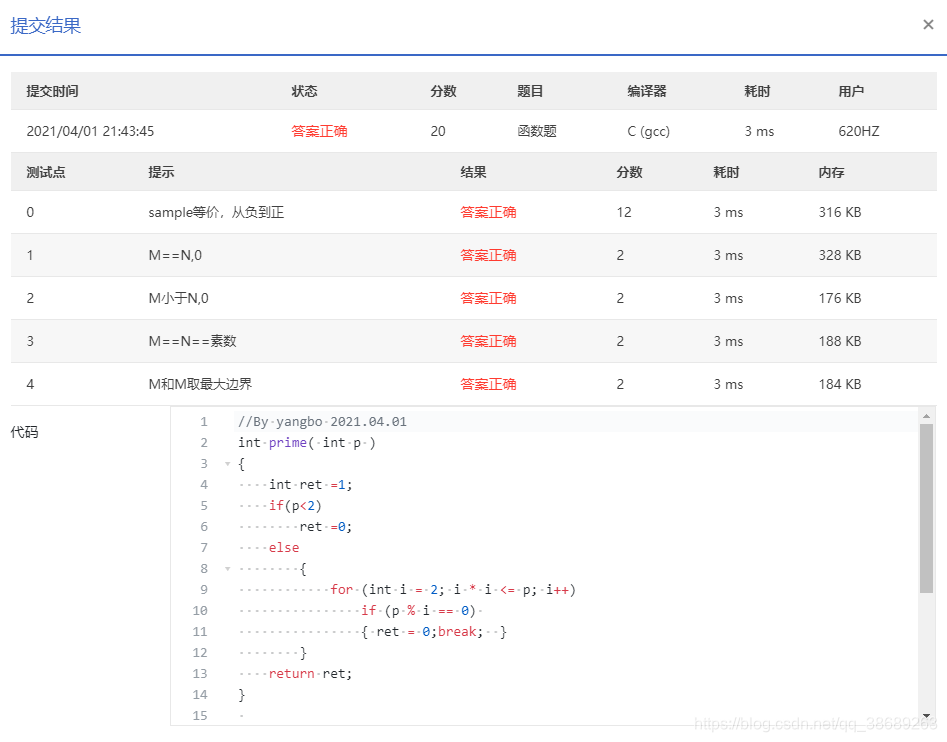习题5-4 使用函数求素数和 (20 分)
本文共 949 字,大约阅读时间需要 3 分钟。
本题要求实现一个判断素数的简单函数、以及利用该函数计算给定区间内素数和的函数。
素数就是。注意:1不是素数,2是素数。
函数接口定义:
int prime( int p );int PrimeSum( int m, int n );
其中函数prime当用户传入参数p为素数时返回1,否则返回0;函数PrimeSum返回区间[m, n]内所有素数的和。题目保证用户传入的参数m≤n。
裁判测试程序样例:
#include#include int prime( int p );int PrimeSum( int m, int n );int main(){ int m, n, p; scanf("%d %d", &m, &n); printf("Sum of ( "); for( p=m; p<=n; p++ ) { if( prime(p) != 0 ) printf("%d ", p); } printf(") = %d\n", PrimeSum(m, n)); return 0;}/* 你的代码将被嵌在这里 */
输入样例:
-1 10
输出样例:
Sum of ( 2 3 5 7 ) = 17
参考代码:
//By yangbo 2021.04.01int prime( int p ){ int ret =1; if(p<2) ret =0; else { for (int i = 2; i * i <= p; i++) if (p % i == 0) { ret = 0;break; } } return ret;} int PrimeSum( int m, int n ){ int s = 0; for( int p=m; p<=n; p++ ) { if( prime(p) != 0 ) s+=p; } return s;} 
转载地址:http://bnii.baihongyu.com/
你可能感兴趣的文章
No module named tensorboard.main在安装tensorboardX的时候遇到的问题
查看>>
No module named ‘MySQLdb‘错误解决No module named ‘MySQLdb‘错误解决
查看>>
No new migrations found. Your system is up-to-date.
查看>>
No qualifying bean of type XXX found for dependency XXX.
查看>>
No qualifying bean of type ‘com.netflix.discovery.AbstractDiscoveryClientOptionalArgs<?>‘ available
查看>>
No resource identifier found for attribute 'srcCompat' in package的解决办法
查看>>
no session found for current thread
查看>>
No static resource favicon.ico.
查看>>
no such file or directory AndroidManifest.xml
查看>>
No toolchains found in the NDK toolchains folder for ABI with prefix: mips64el-linux-android
查看>>
NO.23 ZenTaoPHP目录结构
查看>>
no1
查看>>
NO32 网络层次及OSI7层模型--TCP三次握手四次断开--子网划分
查看>>
NOAA(美国海洋和大气管理局)气象数据获取与POI点数据获取
查看>>
NoClassDefFoundError: org/springframework/boot/context/properties/ConfigurationBeanFactoryMetadata
查看>>
node exporter完整版
查看>>
node HelloWorld入门篇
查看>>
Node JS: < 一> 初识Node JS
查看>>
Node JS: < 二> Node JS例子解析
查看>>
Node Sass does not yet support your current environment: Windows 64-bit with Unsupported runtime(72)
查看>>